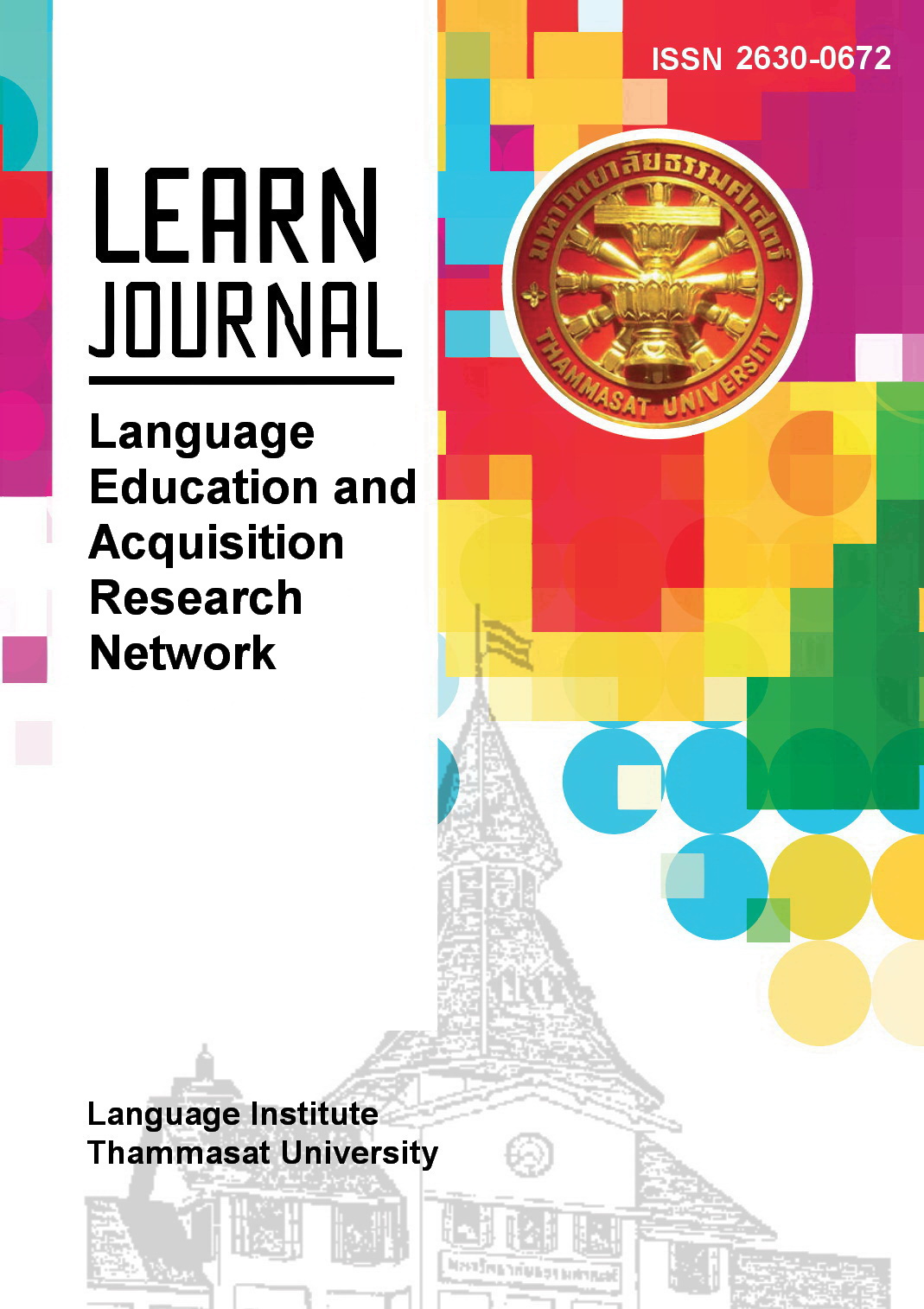An Exploration of Culture in Listening and Speaking Materials from an English as an International Language Perspective
Main Article Content
Abstract
As material that projects linguistic and cultural knowledge to students, English Language learning textbooks shape students’ learning in various educational contexts. However, many textbooks have been found to perpetuate Anglo-Western norms and beliefs; thus, they fail to represent local students’ socio-cultural backgrounds. With this in mind, our study analyzes listening–speaking sections of ten textbooks used in leading Thai universities. More specifically, through a perspective on cultural content sources (i.e., local, target, international, and neutral content), in combination with a deeper two-level analysis of such cultural content (surface and deep), we explore cultural contents integrated in listening-speaking sections of the ten textbooks selected. Findings indicated that three patterns of multiple cultural contents were well integrated in five of the ten textbooks: Touchstone, Speakout, Navigate, Unlock, and Prism. These five books seemed to embrace much broader multicultural content that represented non-Western students’ histories and their global counterparts. Despite the overall low frequency of local students’ realities portrayed in the sampled textbooks, our findings indicate that textbook authors and publishers have begun to acknowledge students’ realities in terms of English being an international language. We suggest directions practitioners and researchers can explore so that learners can be exposed to linguistically and culturally appropriate content.
Article Details
References
Ashrafi, S., Ajideh, P. (2018). Exploring culture-related content in English textbooks: A closer look at advanced series of Iran language institute. Journal of Applied Linguistics and Applied Literature: Dynamics and Advances, 6(1), 91-109. http://journal.azaruniv.ac.ir/article_13821.html
Bauer, M. (Ed.) (2000). Classical content analysis: A review. SAGE Publications Ltd, https://dx.doi.org/10.4135/9781849209731
Bowen, N. E. J. A., & Hopper, D. (2022). The representation of race in
English language learning textbooks: Inclusivity and equality in images. TESOL Quarterly, OnlineFirst. https://doi.org/10.1002/tesq.3169
Brody, J. (2003). A linguistic anthropological perspective on language
and culture in the second language curriculum In D. Lange, & R. M. Page (Eds.), Culture as the core: Perspectives on culture in second language education (pp. 37-52). Greenwich Information Age Pub lishing INC.
Byram, M., Gribkova, B., & Starkey, H. (2002). Developing the intercultural dimension in language teaching: A practical introduction for teachers. Council of Europe.
Celce-Murcia, M. (2008). Rethinking the Role of Communicative
Competence in Language Teaching. In E. A. Soler & M. S. Jordà (Eds), Intercultural language use and language learning (pp. 41-57). Springer. https://doi.org/10.1007/978-1-4020-5639-0_3
Cortazzi, M., & Jin, L. X. (1999). Cultural mirrors: Materials and
methods in the EFL classroom. In E. Hinkel (Ed.), Culture in second language teaching and learning (pp. 196-219). Cambridge: Cambridge University Press.
Hakander, L. (2018). Cultural representations in English textbooks: A content analysis of Viewpoints 1, 2, and 3. Lund University.
https://lup.lub.lu.se/luur/download?func=downloadFile&recordOId=8971895&fileOId=8971899
Hall, E. T. (1976). Beyond culture. Anchor.
Harmer, J. (2015). The practice of English language teaching.
Pearson/Longman.
Hosseinzadeh, M., Heidari, F., & Choubsaz, Y. (2021). A comparative
analysis of the cultural contents and elements in รnternational and localized ELT textbooks. International Journal of Society, Culture & Language, 10(1), 109-124. http://www.ijscl.net/article_246790_e666d3b6b0b1f6166dfaa488583bd0ff.pdf
Hutchinson, T., & Torres, E. (1994). The textbook as agent of change. ELT Journal, 48(4), 315–328. https://doi.org/10.1093/elt/48.4.315
Gómez Rodríguez, L. F. (2015). The cultural content in EFL textbooks and what teachers need to do about it. PROFILE Issues in Teachers' Professional Development, 17(2), 167–187. https://doi.org/10.15446/profile.v17n2.44272
Keles, U., & Yazan, B. (2020). Representation of cultures and communities in a global ELT textbook: A diachronic content analysis. Language Teaching Research, https://doi.org/10.1177/1362168820976922
Kirkpatrick, A. (2014). English as a Medium of Instruction in East and Southeast Asian Universities. In N. Murray & A. Scarino. (Eds), Dynamic Ecologies. Multilingual Education, vol 9. Springer, Dordrecht. https://doi.org/10.1007/978-94-007-7972-3_2
McKay, S. (2012). 5. Teaching materials for English as an international language. In A. Matsuda (Ed.), Principles and practices of teaching English as an international language (pp. 70-83). Multilingual Matters. https://doi.org/10.21832/9781847697042-007Moran, R. T. (2001). Teaching culture: Perspectives in practice. Heinle & Heinle.
Moran, R. T. (2001). Teaching culture: Perspectives in practice. Heinle & Heinle.
Pearson. (2023, January 7). Speakout. https://www.pearson.com/english/catalogue/
general-english/speakout-2nd-edition.html
Raigón-Rodríguez, A. (2018). Analysing cultural aspects in EFL textbooks: A skill-based analysis. Journal of English Studies, 16, 281-300. https://doi.org/10.18172/jes.3478
Risager, K. (2018). Representations of the world in language textbooks. Multilingual Matters. https://doi.org/10.21832/RISAGE9559
Rose, H., McKinley, J., & Galloway, N. (2021). Global Englishes and language teaching: A review of pedagogical research. Language Teaching, 54(2), 157-189. doi:10.1017/S0261444820000518
Seidlhofer, B. (2003). A concept of international English and related issues: From 'real English' to 'realistic English'? Language Policy Division, DG-IV - Directorate of School, Out-of-School and Higher Education, Council of Europe.
Selvi, A. F., & Kocaman, C. (2020). (mis-/under-)representations of gender and sexuality in locally-produced ELT materials. Journal of Language, Identity & Education, 20(2), 118–133. https://doi.org/10.1080/15348458.2020.1726757
Shaules, J. (2007). Deep culture: The hidden challenges of global living. Multilingual Matters.
Sharifian, F. (2013). Globalisation and developing metacultural competence in learning English as an international language. Multilingual Education, 3(7), 1-11. https://doi.org/10.1186/2191-5059-3-7
Smith, L.E. (2009). Dimensions of Understanding in Cross-Cultural Communication. In K. Murata, & J. Jenkins (Eds), Global Englishes in Asian contexts (pp. 17-25) Palgrave Macmillan. https://doi.org/10.1057/9780230239531_2
Tajeddin, Z., & Teimournezhad, S. (2014). Exploring the hidden agenda in the representation of culture in international and localised ELT textbooks. The Language Learning Journal, 43(2), 180–193. https://doi.org/10.1080/09571736.2013.869942
Teo, A. & Kaewsakul, W. (2016). Cultural contents in fundamental
English coursebooks. NIDA Journal Language and Communication, 21(27), 1-17.
https://so04.tci-thaijo.org/index.php/NJLC/article/view/54551
Thongrin, S. (2018). Integrating moral education into language
education in Asia: Guidelines for materials writers. In P. W. Handoyo, M. R. Perfecto, L. V. Canh, & A. Buripakdi (Eds.), Situating moral and cultural values in the ELT materials: The Southeast Asian context (pp. 153-174). Springer .https://doi.org/10.1007/978-3-319-63677-1_9
Tomlinson, B. (2005). The future for ELT materials in Asia. Electronic
Journal of Foreign Language Teaching, 2(2).5‒13. https://e-flt.nus.edu.sg/wpcontent/uploads/2020/09/v2n22005/tomlinson.pdf
Zhang, X., & Su, X. (2021). A cross-national analysis of cultural
representations in English textbooks used in China and Germany. SN Social Sciences, 1(4). https://doi.org/10.1007/s43545-021-00088-8


